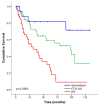Predictors of Mortality in Patients with Interstitial Lung Disease-Associated Pulmonary Hypertension
- PMID: 33255999
- PMCID: PMC7760529
- DOI: 10.3390/jcm9123828
Predictors of Mortality in Patients with Interstitial Lung Disease-Associated Pulmonary Hypertension
Abstract
Background: Pulmonary hypertension (PH) is a well-established complication in interstitial lung disease (ILD) patients. The aim of this study is to investigate the physiological and hemodynamic parameters that predict mortality in patients with ILD-PH.
Methods: Consecutive ILD patients who underwent right heart catheterization (n = 340) were included. The information analyzed included demographics and physiological and hemodynamic parameters. Cox regression models were used to identify independent predictors of survival.
Results: In total, 96 patients had PH and an additional 56 patients had severe PH. The overall survival of idiopathic pulmonary fibrosis (IPF) patients with PH was significantly worse than the survival of patients with other types of ILD with PH (p < 0.0001 by log-rank analysis). Patients with a reduced diffusing capacity of the lung for carbon monoxide (DLco) (<35% predicted), six-minute walk test final oxygen saturation by pulse oximetry (SpO2) <88% and pulmonary vascular resistance ≥4.5 Wood units in the ILD-PH cohort had significantly worse survival. IPF diagnosis, forced vital capacity, DLco, systolic pulmonary artery pressure and cardiac index were identified as independent predictors of survival among the ILD-PH cohort.
Conclusions: Patients with ILD-PH have poor prognosis. Physiological and hemodynamic parameters were important factors independently associated with outcome.
Keywords: idiopathic pulmonary fibrosis; interstitial lung disease; pulmonary hypertension; pulmonary vascular resistance; six-minute walk test; survival.
Conflict of interest statement
None of the authors have conflicts of interest to disclose.
Figures



References
-
- Hoeper M.M., Behr J., Held M., Grunig E., Vizza C.D., Vonk-Noordegraaf A., Lange T.J., Claussen M., Grohe C., Klose H., et al. Pulmonary Hypertension in Patients with Chronic Fibrosing Idiopathic Interstitial Pneumonias. PLoS ONE. 2015;10:e0141911. doi: 10.1371/journal.pone.0141911. - DOI - PMC - PubMed
-
- Gall H., Felix J.F., Schneck F.K., Milger K., Sommer N., Voswinckel R., Franco O.H., Hofman A., Schermuly R.T., Weissmann N., et al. The Giessen Pulmonary Hypertension Registry: Survival in pulmonary hypertension subgroups. J. Heart Lung Transplant. 2017;36:957–967. doi: 10.1016/j.healun.2017.02.016. - DOI - PubMed
-
- Shlobin O.A., Kouranos V., Barnett S.D., Alhamad E.H., Culver D.A., Barney J., Cordova F.C., Carmona E.M., Scholand M.B., Wijsenbeek M., et al. Physiological predictors of survival in patients with sarcoidosis-associated pulmonary hypertension: Results from an international registry. Eur. Respir. J. 2020;55 doi: 10.1183/13993003.01747-2019. - DOI - PubMed
LinkOut - more resources
Full Text Sources

